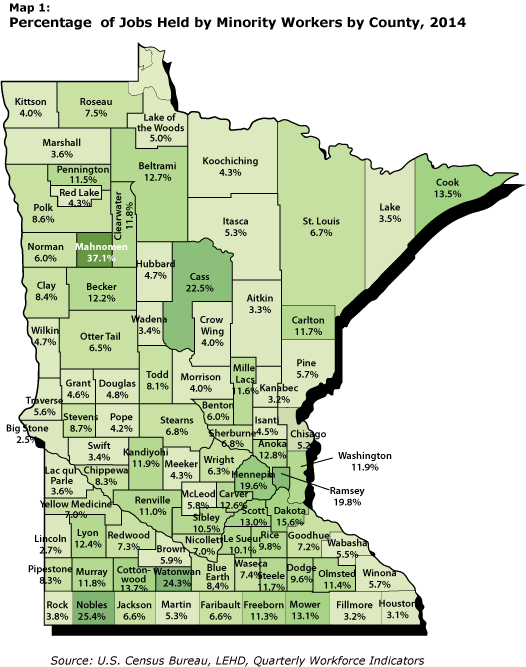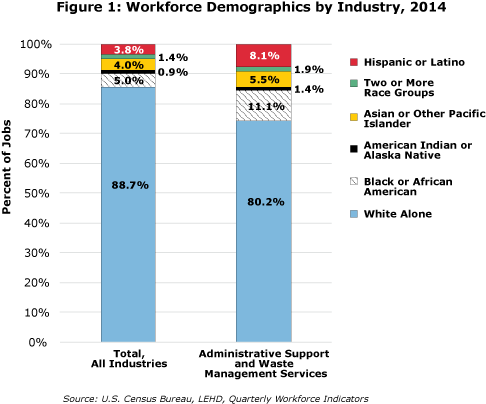
by Cameron Macht
December 2015
The number of jobs held by minority workers in Greater Minnesota has more than doubled over the past two decades.
Though still less diverse than the Twin Cities, Greater Minnesota is seeing greater diversity in its workforce. In fact, the number of jobs filled by minority workers increased faster in the 80 counties of Greater Minnesota than the seven-county Twin Cities metro area over the past 20 years.
The Twin Cities is home to just over 60 percent of the state's jobs and more than 75 percent of the jobs held by minority workers. There are pockets of diversity, however, in Greater Minnesota.
Mahnomen County in northwestern Minnesota has the highest percentage of jobs filled by minorities, followed by Nobles and Watonwan counties in the southwest, and Cass County in the northwest.
Hennepin and Ramsey County have 237,599 of the 386,437 jobs held by minority workers in the state. Hennepin has 173,094 of those jobs and Ramsey County has 64,505 of those jobs. Together, that is 61.5% of the state's jobs held by minority workers.

Data clearly show that minority workers continue to make up an expanding piece of the employment puzzle in Greater Minnesota. According to the U.S. Census Bureau's Quarterly Workforce Indicators program (QWI), the number of jobs held by minority workers in Greater Minnesota more than doubled over the past two decades, rising from about 35,000 jobs in 1995 to just over 88,000 jobs in 2014, a 149 percent increase.
In sum, 8.3 percent of the jobs in Greater Minnesota are now filled by people who identify their race as something other than white alone or white with a Hispanic or Latin origin.
By comparison, 18 percent of the jobs in the Twin Cities and 14.2 percent of the jobs statewide fall into that category. Every region in the state saw an increase in the number of jobs held by minorities over the past 20 years, with Greater Minnesota seeing a faster increase than the Twin Cities. Outside the Twin Cities, the most diverse workforces are found in the southeast and southwest, while the northeast has the least diverse workforce overall (see Table 1).
| Table 1: Percentage of Jobs Held by Minorities by Region, 1995-2014 | |||
|---|---|---|---|
| - | 1995 | 2014 | 1995-2014 |
| Twin Cities | 9.5% | 18.0% | 8.5% |
| Greater Minnesota | 4.1% | 8.3% | 4.2% |
| Southeast | 4.4% | 9.8% | 5.4% |
| Southwest | 4.3% | 9.4% | 5.1% |
| Northwest | 4.6% | 8.4% | 3.8% |
| Central | 3.3% | 7.0% | 3.7% |
| Northeast | 3.9% | 6.8% | 2.9% |
| State of Minnesota | 7.4% | 14.2% | 6.8% |
| Source: U.S. Census Bureau, LEHD, Quarterly Workforce Indicators | |||
More than 85 percent of the jobs in the state that are filled by African American and Asian workers are located in the Twin Cities.
Black workers hold almost 117,000 jobs in the Twin Cities, accounting for over 7 percent of total jobs. But they hold just 1.8 percent of the jobs (19,500) in Greater Minnesota. Likewise, the Twin Cities had just over 91,000 jobs filled by Asians in 2014, about 5.5 percent of total jobs. That compares with 1.5 percent of jobs in Greater Minnesota filled by Asians (see Table 2).
| Table 2: Number and Percentage of Jobs Held by Workers by Race or Origin, 2014 | ||||
|---|---|---|---|---|
| Race or Origin Category | Twin Cities | Greater Minnesota | ||
| Number | Percent | Number | Percent | |
| Total, All Jobs | 1,654,055 | 100.0% | 1,058,227 | 100.0% |
| White Alone | 1,408,957 | 85.2% | 997,559 | 94.3% |
| Black or African American | 116,891 | 7.1% | 19,498 | 1.8% |
| American Indian or Alaska Native | 10,941 | 0.7% | 14,306 | 1.4% |
| Asian or Other Pacific. Islander | 91,197 | 5.5% | 16,320 | 1.5% |
| Two or More Races | 26,070 | 1.6% | 10,549 | 1.0% |
| Hispanic or Latino Origin | 69,289 | 4.2% | 35,131 | 3.3% |
| Source: U.S. Census Bureau, LEHD, Quarterly Workforce Indicators | ||||
In contrast, Greater Minnesota accounts for 57 percent of the jobs held by American Indians in the state. With just 25,247 jobs statewide, however, American Indians hold the smallest number of jobs of any race group in the state, and the second smallest in Greater Minnesota, ahead of workers of two or more race groups.
People of Latino origin are the largest minority group of job holders in Greater Minnesota, with just over 35,000 jobs. That is about half the number of jobs held by Latino workers in the Twin Cities. Latino workers also saw the biggest increase in jobs in Greater Minnesota over the past 20 years.
Health care and social assistance is the largest industry in the state, with more than 455,000 jobs in 2014. It is also one of the most diverse industries.
Statewide, health care and social assistance accounted for 16.8 percent of total jobs but 31.8 percent of the jobs held by black workers. In fact, it was the highest-employing industry for black workers in the state, providing more than 42,000 jobs in 2014. More than 37,000 of those jobs, however, were in the Twin Cities metro area, while the remaining 5,000 were in Greater Minnesota.
Blacks accounted for 15 percent of the health care and social assistance workforce in the Twin Cities, but they held just 2.3 percent of health care jobs in Greater Minnesota. Nonetheless, the sector was still the largest-employing industry for blacks outside the Twin Cities.
In the Twin Cities, health care and social assistance was also the largest-employing industry for whites, American Indians, and workers of two or more races. It was the second largest for Asians and the third largest for Latinos.
Greater Minnesota health care facilities rely more heavily on Latino workers. Regardless of location, every race group gained huge numbers of jobs in health care and social assistance over the past 20 years, with most minority groups more than doubling from 1995 to 2014 (see Table 3).
| Table 3: Health Care and Social Assistance Jobs by Race or Origin, 1995-2014 | ||||||
|---|---|---|---|---|---|---|
| Twin Cities | Greater Minnesota | |||||
| Jobs, 1995 | Jobs, 2014 | Change from 1995-2014 | Jobs, 1995 | Jobs, 2014 | Change from1995-2014 | |
| All Races | 139,870 | 242,620 | 73.5% | 131,509 | 212,581 | 61.6% |
| White Alone | 125,153 | 183,386 | 46.5% | 128,388 | 199,429 | 55.3% |
| Black or African American | 9,244 | 37,164 | 302.0% | 528 | 4,933 | 834.3% |
| American Indian or Alaska Native | 1,033 | 1,732 | 67.7% | 823 | 2,264 | 175.1% |
| Asian or Other Pacific. Islander | 3,250 | 16,081 | 394.8% | 1,100 | 3,887 | 253.4% |
| Two or More Races | 1,189 | 4,256 | 257.9% | 668 | 2,068 | 209.6% |
| Hispanic or Latino | 2,482 | 8,753 | 252.7% | 1,281 | 5,080 | 296.6% |
| Source: U.S. Census Bureau, LEHD, Quarterly Workforce Indicators | ||||||
Case Study: Morningside Heights Care CenterMorningside Heights Care Center, a 76-bed long-term care facility that is part of Avera Marshall Regional Medical Center in Marshall, has doubled the diversity of its workforce in recent years. Avera's Kimberly Torkelson said 27 percent of the care center's workforce is now of a race or origin other than white alone. Five years ago that figure was at 13 percent. When fully staffed, the care center employs more than 100 direct care employees, including registered nurses (RNs), licensed practical nurses (LPNs), neighborhood coordinators, certified nursing assistants (CNAs), trained medication assistants (TMAs) and dietary aides. Currently, Morningside Heights has openings for CNAs, TMAs and LPNs. In an effort to reach out to new workers, Avera has held question-and-answer sessions with community members and leaders of different races and cultures. Attendees toured the facility and had a chance to ask questions. "One of the things we learned was that there was a need for more than CNA positions here, as many people do not have their certifications right away," Torkelson said. "So, we redesigned our scheduling and created two dietary aide positions. These positions do not require a CNA certification and can be used as a stepping stone to a CNA position. It helps the individual gain a working knowledge of how our facility operates and a bigger glimpse of what CNA work looks like." Avera also has been working with DEED WorkForce Center partners, including the Southwest Minnesota Private Industry Council and Adult Basic Education. One particularly effective program has been Minnesota FastTRAC (now known as Pathways to Prosperity), which helps under-prepared adults learn basic job skills and career-specific expertise in high-demand occupations. The program has helped applicants develop their skills as dietary aides. "We have hired many of these students, and it has been wonderful watching them grow into their new roles here at Avera," remarked Torkelson. "Many of the employees of other cultures that we have employed here have come from these programs." Employee referrals have also played a large role in attracting a diverse workforce. "Employees like it here, and they encourage their friends and relatives to seek positions here as well," Torkelson said. Morningside Heights has a couple of residents who speak only Spanish. Having Latino staff members who can communicate with them leads to more comfort and satisfaction for residents, she said. "It is enjoyable watching the staff and residents learn more about the cultures of the staff and residents we have here. They feel comfortable asking questions and sharing about their individual backgrounds," she added. Avera knows that it is competing in a tight labor market where many businesses are looking for help. Torkelson's advice is to talk with employees and seek their opinions on hiring and retention, because some of the best ideas come from current staff. "We are tasked with making our positions and organizations look attractive and different from the rest. This can be a difficult thing in today's world," Torkelson said. "I would suggest to have an open mind and to think outside of the box. Be creative with your staffing. Just because something has worked for the last five to 10 years, does not mean that it will work today. Change things up." |
The second-largest employing industry in the state is manufacturing, with about 310,000 jobs in 2014. But it was the largest source of jobs for Asians, providing more than 21,500 jobs statewide, and for workers of Latino origin, accounting for 18,420 jobs.
Greatly affected by the last two recessions, manufacturing employment dropped from about 380,000 jobs in 1995 to 290,000 jobs in 2010, before rebounding and adding about 20,000 jobs in the past five years.
The number of manufacturing jobs fell twice as fast in the Twin Cities as in Greater Minnesota over the past 20 years, resulting in declines for both whites and American Indians in this sector. But all other minority groups gained jobs in manufacturing over the period, with growth occurring faster in outstate areas.
About one in nine manufacturing jobs in the Twin Cities was held by Asians, making it the largest-employing industry for that race group in the metro area.
The number of Latinos in manufacturing jobs more than doubled from 1995 to 2014. Greater Minnesota had more manufacturing jobs held by Latinos than the Twin Cities, with the largest concentrations in southeastern, southwestern and central Minnesota.
As the economy has recovered, manufacturing and other industries have relied heavily on temporary staffing agencies for workers. Temp help agencies are included in the administrative support and waste management services sector. This sector has one of the fastest-growing and most diverse workforces in the state, employing higher than average concentrations of workers of every race other than whites. The most minority held jobs were held by black workers, followed by Latinos and Asians (see Figure 1).

The administrative support and waste management services workforce is much larger and more diverse in the Twin Cities, but diversity has been increasing much faster in Greater Minnesota over the past 20 years. The number of jobs held by workers of every race group other than white or Asian more than tripled in Greater Minnesota from 1995 to 2014.
Job holders in the retail trade, the accommodation and food services, and the arts, entertainment and recreation industries are also relatively diverse. Not only do those industries tend to have much higher numbers of young workers, but they also employ large numbers of workers of other races and origins.
In the Twin Cities, the retail trade and the accommodation and food services industries together employ more than 22,000 blacks, 15,000 Asians and 7,000 workers of two or more races.
While retail trade is less diverse in Greater Minnesota, accommodation and food services is the second-largest employing industry for people of two or more races, the third-largest for blacks, Asians and workers of Latino origin, and the fourth-largest source of jobs for American Indians.
Accommodation and food services provides about 12 percent of jobs held by American Indians in the state, compared with 8 percent of all workers. Though arts, entertainment and recreation (which includes casinos) provides just 1.8 percent of total jobs in Greater Minnesota, the industry accounts for 15.1 percent of jobs held by American Indians.
In addition, public administration is the largest-employing industry for American Indians in Greater Minnesota, often in tribal governments. That makes it the largest minority group working in public administration, just ahead of blacks.
The natural resources and mining sectors offer a stark contrast in diversity. On one hand, the agriculture, forestry, fishing and hunting sector has a relatively diverse workforce, with just over 12 percent of jobs held by workers of Latino origin in Greater Minnesota. On the other hand, over 98 percent of mining jobs are held by whites. Of the 7,000 jobs in mining across the state, fewer than 180 of those jobs were filled by minorities in 2014.
Other industries that have lower concentrations of minority job holders include construction, wholesale trade, educational services, finance and insurance, and professional and technical services. All of those industries, however, saw huge jumps in the number of jobs held by minorities over the past 20 years, with many of them doubling or tripling the number of minority workers from 1995 to 2014 (see Table 4).
| Table 4: Change in Jobs by Industry by Race or Origin in Greater Minnesota, 1995 to 2014 | |||||||
|---|---|---|---|---|---|---|---|
| - | All Races | White Alone | Black or African American | American Indian or Alaska Native | Asian or Other Pacific Islander | Two or More Races | Hispanic or Latino |
| Total, All Industries | +22.3% | +18.7% | +310.9% | +85.7% | +95.3% | +133.4% | +157.0% |
| Agriculture, Forestry and Fishing | +94.0% | +85.8% | +1,017.9% | +143.9% | +454.9% | +427.5% | +204.0% |
| Admin. Support and Waste Mgmt. | +81.9% | +72.3% | +450.7% | +270.7% | +50.2% | +214.9% | +214.5% |
| Health Care and Social Assistance | +61.6% | +55.3% | +834.3% | +175.1% | +253.4% | +209.6% | +296.6% |
| Management of Companies | +61.3% | +55.6% | +2,600.0% | +75.0% | +258.3% | +213.3% | +339.5% |
| Professional and Technical Services | +56.6% | +52.6% | +470.3% | +105.6% | +414.7% | +209.8% | +224.8% |
| Transportation and Warehousing | +48.9% | +46.8% | +117.1% | +59.1% | +137.2% | +188.9% | +176.3% |
| Construction | +42.9% | +41.3% | +330.4% | +43.7% | +163.4% | +170.3% | +262.0% |
| Public Administration | +38.3% | +32.6% | +177.9% | +222.9% | +146.0% | +161.7% | +170.0% |
| Educational Services | +24.5% | +23.2% | +158.2% | +18.3% | +120.4% | +93.6% | +132.8% |
| Accommodation and Food Services | +20.7% | +15.0% | +304.5% | +200.4% | +50.0% | +177.0% | +196.1% |
| Arts, Entertainment and Recreation | +20.4% | +16.3% | +191.7% | +36.4% | +40.0% | +106.3% | +56.1% |
| Wholesale Trade | +16.4% | +15.0% | +167.2% | +64.4% | +138.3% | +121.6% | +145.7% |
| Real Estate, Rental and Leasing | +13.8% | +12.1% | +257.1% | +6.3% | +93.1% | +45.5% | +51.3% |
| Other Services | +13.6% | +12.9% | +230.6% | -55.7% | +134.2% | +62.7% | +66.3% |
| Finance and Insurance | +10.4% | +10.2% | -30.8% | +63.8% | +39.3% | +106.2% | +117.4% |
| Retail Trade | +4.4% | +1.7% | +194.2% | +76.0% | +82.3% | +115.8% | +139.7% |
| Manufacturing | -11.0% | -14.1% | +303.4% | +23.2% | +37.2% | +62.5% | +118.2% |
| Information | -15.5% | -17.1% | +57.3% | +10.0% | +106.9% | +60.0% | +42.3% |
| Utilities | -17.4% | -17.6% | -30.0% | -26.5% | 0.0% | +27.6% | +34.4% |
| Mining | -18.4% | -18.9% | +42.9% | -7.1% | +50.0% | +33.3% | +48.5% |
| Source: U.S. Census Bureau, LEHD, Quarterly Workforce Indicators | |||||||
Utilities was the only industry in the state to see a decline in the number of jobs held by minorities over the past two decades. The industry also saw a decline in jobs overall, including white workers. Every other industry enjoyed a rapid increase in workforce diversity over time, especially in Greater Minnesota.